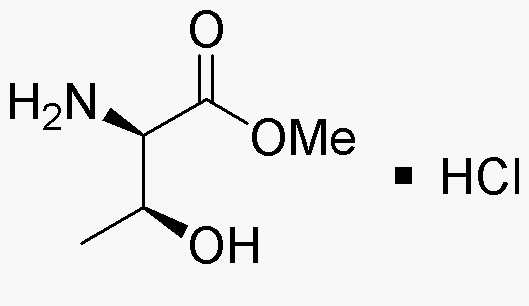D-Threonine methyl ester hydrochloride is widely utilized in research focused on:
- Peptide Synthesis: This compound serves as a building block in the synthesis of peptides, which are crucial in drug development and biochemistry.
- Pharmaceutical Formulations: It is used in the formulation of various pharmaceuticals, enhancing the solubility and bioavailability of active ingredients.
- Nutrition Supplements: Commonly found in dietary supplements, it aids in muscle recovery and overall health, particularly for athletes and fitness enthusiasts.
- Biochemical Research: Researchers utilize it to study metabolic pathways and protein interactions, providing insights into cellular functions.
- Cosmetic Applications: The compound is incorporated into skincare products for its moisturizing properties, benefiting formulations aimed at hydration and skin repair.
General Information
Properties
Safety and Regulations
Applications
D-Threonine methyl ester hydrochloride is widely utilized in research focused on:
- Peptide Synthesis: This compound serves as a building block in the synthesis of peptides, which are crucial in drug development and biochemistry.
- Pharmaceutical Formulations: It is used in the formulation of various pharmaceuticals, enhancing the solubility and bioavailability of active ingredients.
- Nutrition Supplements: Commonly found in dietary supplements, it aids in muscle recovery and overall health, particularly for athletes and fitness enthusiasts.
- Biochemical Research: Researchers utilize it to study metabolic pathways and protein interactions, providing insights into cellular functions.
- Cosmetic Applications: The compound is incorporated into skincare products for its moisturizing properties, benefiting formulations aimed at hydration and skin repair.
Documents
Safety Data Sheets (SDS)
The SDS provides comprehensive safety information on handling, storage, and disposal of the product.
Product Specification (PS)
The PS provides a comprehensive breakdown of the product’s properties, including chemical composition, physical state, purity, and storage requirements. It also details acceptable quality ranges and the product's intended applications.
Certificates of Analysis (COA)
Search for Certificates of Analysis (COA) by entering the products Lot Number. Lot and Batch Numbers can be found on a product’s label following the words ‘Lot’ or ‘Batch’.
*Catalog Number
*Lot Number
Certificates Of Origin (COO)
This COO confirms the country where the product was manufactured, and also details the materials and components used in it and whether it is derived from natural, synthetic, or other specific sources. This certificate may be required for customs, trade, and regulatory compliance.
*Catalog Number
*Lot Number
Safety Data Sheets (SDS)
The SDS provides comprehensive safety information on handling, storage, and disposal of the product.
DownloadProduct Specification (PS)
The PS provides a comprehensive breakdown of the product’s properties, including chemical composition, physical state, purity, and storage requirements. It also details acceptable quality ranges and the product's intended applications.
DownloadCertificates of Analysis (COA)
Search for Certificates of Analysis (COA) by entering the products Lot Number. Lot and Batch Numbers can be found on a product’s label following the words ‘Lot’ or ‘Batch’.
*Catalog Number
*Lot Number
Certificates Of Origin (COO)
This COO confirms the country where the product was manufactured, and also details the materials and components used in it and whether it is derived from natural, synthetic, or other specific sources. This certificate may be required for customs, trade, and regulatory compliance.


